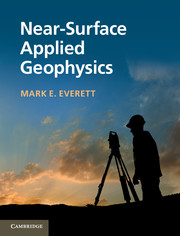Book contents
- Frontmatter
- Contents
- Preface
- Acknowledgments
- 1 Introduction
- 2 Data analysis
- 3 Magnetics
- 4 Electrical resistivity method
- 5 Induced polarization and self-potential
- 6 Seismic reflection and refraction
- 7 Seismic surface-wave analysis
- 8 Electromagnetic induction
- 9 Ground-penetrating radar
- 10 Emerging techniques
- 11 Linear inversion
- 12 Non-linear inversion: local methods
- 13 Non-linear inversion: global methods
- Appendix A Shannon sampling theorem
- Appendix B Solution of Laplace’s equation in spherical coordinates
- Appendix C The linear τ–p transformation of seismic data
- Appendix D Horizontal loop over a conducting halfspace
- Appendix E Radar TE waveguide mode equations
- References
- Index
- Plate section
2 - Data analysis
Published online by Cambridge University Press: 05 April 2013
- Frontmatter
- Contents
- Preface
- Acknowledgments
- 1 Introduction
- 2 Data analysis
- 3 Magnetics
- 4 Electrical resistivity method
- 5 Induced polarization and self-potential
- 6 Seismic reflection and refraction
- 7 Seismic surface-wave analysis
- 8 Electromagnetic induction
- 9 Ground-penetrating radar
- 10 Emerging techniques
- 11 Linear inversion
- 12 Non-linear inversion: local methods
- 13 Non-linear inversion: global methods
- Appendix A Shannon sampling theorem
- Appendix B Solution of Laplace’s equation in spherical coordinates
- Appendix C The linear τ–p transformation of seismic data
- Appendix D Horizontal loop over a conducting halfspace
- Appendix E Radar TE waveguide mode equations
- References
- Index
- Plate section
Summary
This chapter provides a general overview of some elementary concepts in geophysical data analysis such as information, sampling, aliasing, convolution, filtering, Fourier transforms, and wavelet analysis. Good introductions to many of these topics may be found in Kanasewich (1981) and Gubbins (2004). The material presented in this chapter is aimed to help the near-surface geophysicist to process and interpret data acquired in the field using the techniques that are discussed in the subsequent chapters of this book.
Information
Geophysicists gather data from which they attempt to extract information about the Earth, in order to better understand its subsurface structure and the wide variety of geological processes that shapes its evolution. The assumption is that geophysical datasets contain information about subsurface geology. It is useful to establish what is meant by the term information. There are many ways to define information but, at the most fundamental level, I regard it as a quantum, or bit, of new knowledge. Special emphasis should be placed on the word new in the foregoing definition, in order to reinforce the concept that previously existing knowledge is not information.
- Type
- Chapter
- Information
- Near-Surface Applied Geophysics , pp. 12 - 33Publisher: Cambridge University PressPrint publication year: 2013



